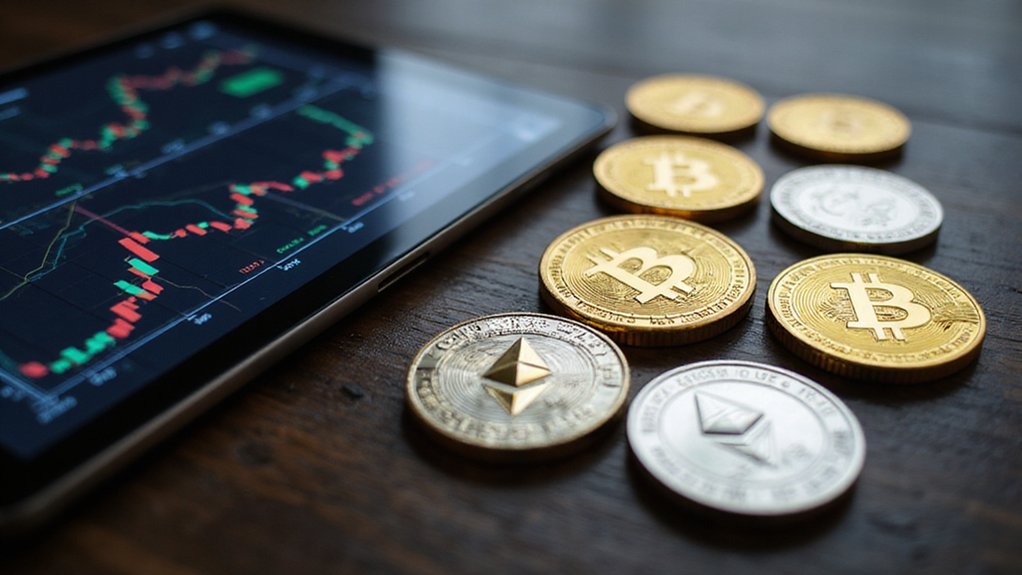Initial Coin Offerings (ICOs) function as cryptocurrency’s answer to traditional IPOs, allowing blockchain projects to raise capital by distributing newly minted tokens to investors—albeit with considerably less regulatory oversight than conventional securities markets. These fundraising mechanisms rely heavily on white papers that serve as both technical blueprints and marketing manifestos, detailing project roadmaps while attempting to distinguish legitimate ventures from questionable schemes. The resulting tokens may grant ecosystem access, voting rights, or profit participation, though their value proposition depends entirely on project success and adoption. The extraordinary risks (including fraud potential and limited legal recourse) demand exceptional caution from participants traversing this largely unregulated terrain where innovation and speculation intersect in fascinating ways.

The cryptocurrency revolution, having already transformed how the world thinks about money and value transfer, spawned what might be considered its most audacious offspring: the Initial Coin Offering (ICO). This fundraising mechanism operates as the crypto world’s answer to traditional Initial Public Offerings, though with markedly less regulatory oversight and—one might argue—considerably more creative interpretation of investment fundamentals.
ICOs function by distributing newly minted cryptocurrency tokens to investors, ostensibly raising capital for blockchain-related projects. The structure varies greatly: some maintain static supply with fixed pricing, others employ dynamic pricing mechanisms that adjust token costs based on funding milestones, while still others modify token quantities while maintaining consistent pricing. These structural variations create fascinating (and occasionally bewildering) valuation dynamics that would make traditional finance professors reach for their antacids.
The launch process centers on the white paper—a document that serves as both technical blueprint and marketing manifesto. These papers detail project roadmaps, team credentials, funding requirements, and token mechanics, fundamentally functioning as the primary pitch to attract investors. Projects typically establish dedicated websites disseminating ICO data, accepted payment methods (usually Bitcoin or Ethereum), and campaign durations.
The white paper emerges as cryptocurrency’s peculiar hybrid—part technical manual, part investment theater, wholly essential for separating serious ventures from elaborate wishful thinking.
Token utility presents perhaps the most intriguing aspect of ICOs. Purchased tokens may grant ecosystem access, voting rights, profit participation, or—in cases where optimism exceeds functionality—speculative trading opportunities. The value proposition often depends entirely on project success and adoption, creating investment scenarios where due diligence becomes paramount.
However, the largely unregulated nature of ICOs introduces substantial risks. Investors face potential fraud, project failures, and limited legal recourse—a reality that necessitates extraordinary caution. The absence of regulatory guardrails has produced an environment where legitimate innovation coexists with questionable ventures of varying degrees of feasibility. Unlike traditional venture capital or crowdfunding approaches, ICOs provide immediate liquidity for token holders once trading begins.
Creating an ICO involves project planning, white paper development, website creation, and token generation (frequently on Ethereum-based platforms). Marketing and compliance considerations increasingly influence design decisions as regulatory scrutiny intensifies across jurisdictions. Over 1,500 coins are currently available for trading on various exchanges, demonstrating the vast scale of token proliferation in the cryptocurrency ecosystem.
The process culminates in public sales and post-ICO token distribution, completing a fundraising cycle that represents either revolutionary democratization of capital access or a fascinating experiment in collective financial optimism. In 2025, many projects are shifting toward private sales as a more strategic fundraising model, driven by institutional adoption and the need for more controlled funding environments.
Frequently Asked Questions
What Happens to My Investment if an ICO Project Fails Completely?
When an ICO project collapses entirely, investors typically face complete capital loss—their tokens become worthless digital artifacts with zero market value.
Unlike traditional investments with bankruptcy protections, failed ICOs offer no safety net; founders often disappear with remaining funds, leaving investors holding fundamentally nothing.
Legal recourse proves limited at best, particularly given ICOs’ regulatory gray areas.
The harsh reality? That speculative investment simply evaporates into the blockchain ether.
How Can I Tell if an ICO Is a Scam Before Investing?
Identifying ICO scams requires forensic-level due diligence: verify team credentials through LinkedIn (anonymous founders being immediate red flags), scrutinize whitepapers for technical substance versus grandiose promises, examine GitHub repositories for actual development activity, and analyze token economics for manipulation indicators.
Cross-reference details across multiple tracking platforms, monitor social sentiment, and employ machine learning detection tools—because apparently distinguishing legitimate blockchain innovation from elaborate Ponzi schemes requires computational assistance nowadays.
What Are the Tax Implications of Investing in ICO Tokens?
ICO token investments trigger dual taxation events: initial token receipt constitutes taxable income at fair market value, while subsequent sales generate capital gains based on appreciation from cost basis.
Short-term holdings face ordinary income rates (potentially 37%), whereas long-term positions enjoy preferential treatment.
The IRS demands meticulous record-keeping of acquisition dates and values—a task made delightfully complex by cryptocurrency’s volatility and the SEC’s ongoing definitional gymnastics regarding security classification.
Can I Get a Refund if I Change My Mind About Investing?
ICO refunds remain largely mythical—most projects explicitly disclaim refund obligations, leaving investors with fundamentally irreversible commitments.
While some projects offer token buy-back programs (assuming they survive launch), these represent exceptions rather than standard practice.
The decentralized nature and regulatory gaps inherent in ICOs mean traditional consumer protections don’t apply, making buyer’s remorse an expensive lesson in the permanence of blockchain transactions.
How Long Does It Typically Take to Receive Tokens After Investing?
Token distribution timing varies considerably across ICO models, typically occurring within days to weeks post-campaign completion.
Smart contract automation can enable immediate transfers, though vesting periods often delay access (preventing the inevitable dump).
IEOs generally distribute faster through centralized exchanges, while IDOs leverage decentralized liquidity pools for near-instant delivery.
Regulatory compliance, network congestion, and project-specific milestone requirements frequently extend timelines—assuming the project actually delivers tokens at all.









